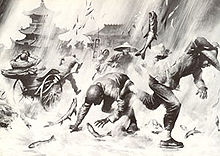
A tornado is a violently rotating column of air that is in contact with both the surface of the Earth and a cumulonimbus cloud or, in rare cases, the base of a cumulus cloud. It is often referred to as a twister, whirlwind or cyclone, although the word cyclone is used in meteorology to name a weather system with a low-pressure area in the center around which, from an observer looking down toward the surface of the Earth, winds blow counterclockwise in the Northern Hemisphere and clockwise in the Southern. Tornadoes come in many shapes and sizes, and they are often visible in the form of a condensation funnel originating from the base of a cumulonimbus cloud, with a cloud of rotating debris and dust beneath it. Most tornadoes have wind speeds less than 180 kilometers per hour, are about 80 meters across, and travel several kilometers before dissipating. The most extreme tornadoes can attain wind speeds of more than 480 kilometers per hour (300 mph), are more than 3 kilometers (2 mi) in diameter, and stay on the ground for more than 100 km (62 mi).

Texarkana is a city in Bowie County, Texas, United States, in the Ark-La-Tex region. Located approximately 180 miles (290 km) from Dallas, Texarkana is a twin city with neighboring Texarkana, Arkansas. The Texas city's population was 36,193 at the 2020 census.
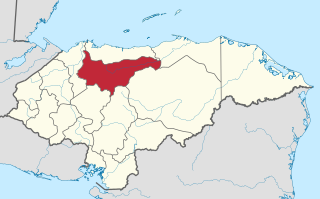
Yoro is one of the 18 departments into which Honduras is divided. The department contains rich agricultural lands, concentrated mainly on the valley of the Aguan River and the Sula Valley, on opposite ends. The departmental capital is Yoro. The department covers a total surface area of 7,939 km2 and, in 2005, had an estimated population of 503,886 people. It is famous for the Lluvia de Peces, a tradition by which fish fall from the sky during very heavy rains.

Weather lore is the body of informal folklore related to the prediction of the weather and its greater meaning.

A waterspout is an intense columnar vortex that occurs over a body of water. Some are connected to a cumulus congestus cloud, some to a cumuliform cloud and some to a cumulonimbus cloud. In the common form, a waterspout is a non-supercell tornado over water having a five-part life cycle: formation of a dark spot on the water surface; spiral pattern on the water surface; formation of a spray ring; development of a visible condensation funnel; and ultimately, decay.
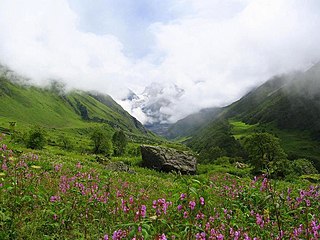
The climate of India consists of a wide range of weather conditions across a vast geographic scale and varied topography. Based on the Köppen system, India hosts six major climatic sub types, ranging from arid deserts in the west, alpine tundra and glaciers in the north, and humid tropical regions supporting rain forests in the southwest and the island territories. Many regions have starkly different microclimates, making it one of the most climatically diverse countries in the world. The country's meteorological department follows the international standard of four seasons with some local adjustments: winter, summer, monsoon or rainy season, and a post-monsoon period.
Yoro, with a population of 27,460, is the capital city of the Yoro Department of Honduras and the municipal seat of Yoro Municipality. It is notable for a local event known as Lluvia de Peces, where it is claimed that strong storms make fish fall from the sky.

Star jelly is a gelatinous substance sometimes found on grass and less commonly on the branches of trees. According to folklore, it is deposited on the Earth during meteor showers. It is described as a translucent or grayish-white gelatin that tends to evaporate shortly after having "fallen". Explanations have ranged from it being the remains of frogs, toads, or worms, to the byproducts of cyanobacteria, to being the fruiting bodies of jelly fungi or masses of amoeba called slime molds. Nonbiological origins proposed for instances of "star jelly" have included byproducts from industrial production or waste management. Reports of the substance date back to the 14th century and have continued to the present.
Karachi has a semi-arid climate, formerly a hot desert climate, albeit a moderate version of this climate, influenced by monsoons. Karachi has a tropical climate, despite being located slightly above the Tropic of Cancer. It is situated in the monsoon region of Pakistan. It is located on the coast bordering the Arabian Sea, and as a result, has a relatively mild climate. However, in more recent years, rainfall has become more abundant. For this reason, the city may be classed as semi-arid (BSh), since it has a mild climate with a short but defined wet season, along with a lengthy dry season.

The Kerala red rain phenomenon was a blood rain event that occurred in Wayanad district of southern Indian state Kerala on Monday, 15 July 1957 and the colour subsequently turned yellow and also 25 July to 23 September 2001, when heavy downpours of red-coloured rain fell sporadically in Kerala, staining clothes pink. Yellow, green and black rain was also reported. Coloured rain was also reported in Kerala in 1896 and several times since, most recently in June 2012, and from 15 November 2012 to 27 December 2012 in eastern and north-central provinces of Sri Lanka.

The lluvia de peces, also known as aguacero de pescado, is a phenomenon that has been occurring yearly for more than a century in Yoro, Honduras, in which fish are said to fall from the sky. It occurs up to four times in a year. It has attracted the attention of scientists, as well as documentary coverage by the History Channel in the United States.
The British Overseas Territory of Bermuda has been affected by several tornadoes and waterspouts in its history.
Bird kill is a localized event resulting in the death of large numbers of birds at the same time.
The Kentucky meat shower was an incident occurring for a period of several minutes between 11 a.m. and 12 p.m. on March 3, 1876, where what appeared to be chunks of red meat fell from the sky in a 100-by-50-yard (90-by-45-meter) area near Olympia Springs in Bath County, Kentucky. There exist several explanations as to how this occurred and what the "meat" was. Although the exact type of meat was never identified, various reports suggested it was beef, lamb, deer, bear, horse, or possibly human.
The 2013 Southeastern United States floods were ongoing flooding across the southeastern U.S. Flash floods began on the morning of July 2 and continued through Independence Day and into the next day. The hardest-hit areas as of Friday afternoon are the Florida Panhandle, northwest Alabama and the area around Columbus, Mississippi. A plume of tropical moisture caused heavy rain to train over the same areas, for more than 36 hours in some cases, leading to flash flooding.
In May 2015, India was struck by a severe heat wave. As of 3 June 2015, it caused the deaths of at least 2,500 people in multiple regions. The heat wave occurred during the Indian dry season, which typically lasts from March to July with peak temperatures in April and May. Although it typically remains hot until late October, Indian monsoons often provide some respite from the heat.

Cyclonic Storm Roanu was a relatively weak tropical cyclone that caused severe flooding in Sri Lanka and Bangladesh during May 2016. It is the first tropical cyclone of the annual cyclone season. Roanu originated from a low-pressure area that formed south of Sri Lanka, which gradually drifted north and intensified into a cyclonic storm on 19 May. However, wind shear and land interaction caused it to weaken slightly, before reintensifying as it accelerated towards the coast of Bangladesh.
A mass mortality event (MME) is an incident that kills a vast number of individuals of a single species in a short period of time. The event may put a species at risk of extinction or upset an ecosystem. This is distinct from the mass die-off associated with short lived and synchronous emergent insect taxa which is a regular and non-catastrophic occurrence.
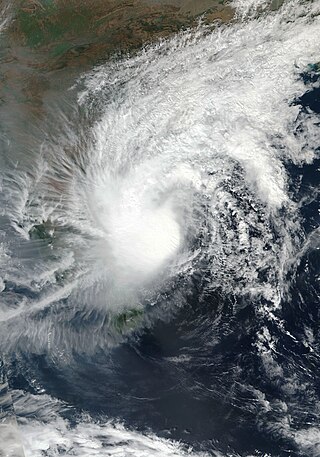
Severe Cyclonic Storm Phethai was a tropical cyclone which affected some portions of Sri Lanka and India during December 2018. The fourteenth depression, ninth deep depression, seventh cyclonic storm, and fifth severe cyclonic storm of the 2018 North Indian Ocean cyclone season, Phethai developed from an area of low pressure that formed over the Bay of Bengal on December 13. Having forecasted not to develop significantly, the depression then strengthened to a deep depression later that day before becoming a cyclonic storm on December 15. Phethai further intensified and peaked to a severe cyclonic storm, the following day. The system then steadily weakened due to land interaction and increasing wind shear, before making landfall as a disorganized system over Andhra Pradesh on December 17. It degenerated to an area of low-pressure inland later that day.
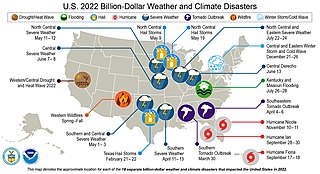
The following is a list of weather events that occurred on Earth in the year 2022. The year began with a La Niña. There were several natural disasters around the world from various types of weather, including blizzards, cold waves, droughts, heat waves, wildfires, floods, tornadoes, and tropical cyclones. The deadliest weather event of the year were the European heat waves, which killed over 26,000 people, 11,000 of which were in France. The costliest weather event of the year was Hurricane Ian, which caused at least $112.9 billion in damages in Florida and Cuba. Another significant weather event was the Pakistan floods, which killed 1,739 people and a total of $14.9 billion in damages.
